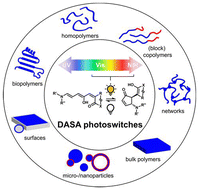Visible light-responsive materials: the (photo)chemistry and applications of donor–acceptor Stenhouse adducts in polymer science
Abstract
Donor–acceptor Stenhouse adduct (DASA) photoswitches have gained a lot of attention since their discovery in 2014. Their negative photochromism, visible light absorbance, synthetic tunability, and the large property changes between their photoisomers make them attractive candidates over other commonly used photoswitches for use in materials with responsive or adaptive properties. The development of such materials and their translation into advanced technologies continues to widely impact forefront materials research, and DASAs have thus attracted considerable interest in the field of visible-light responsive molecular switches and dynamic materials. Despite this interest, there have been challenges in understanding their complex behavior in the context of both small molecule studies and materials. Moreover, incorporation of DASAs into polymers can be challenging due to their incompatibility with the conditions for most common polymerization techniques. In this review, therefore, we examine and critically discuss the recent developments and challenges in the field of DASA-containing polymers, aiming at providing a better understanding of the interplay between the properties of both constituents (matrix and photoswitch). The first part summarizes current understanding of DASA design and switching properties. The second section discusses strategies of incorporation of DASAs into polymers, properties of DASA-containing materials, and methods for studying switching of DASAs in materials. We also discuss emerging applications for DASA photoswitches in polymeric materials, ranging from light-responsive drug delivery systems, to photothermal actuators, sensors and photoswitchable surfaces. Last, we summarize the current challenges in the field and venture on the steps required to explore novel systems and expand both the functional properties and the application opportunities of DASA-containing polymers.

- This article is part of the themed collection: Celebrating the scientific accomplishments of RSC Fellows


 Please wait while we load your content...
Please wait while we load your content...